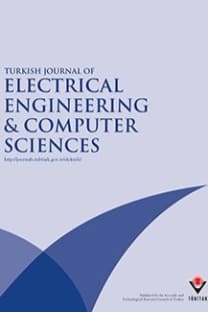A new feature selection model based on ID3 and bees algorithm for intrusion detection system
Intrusion detection system, ID3 algorithm, bees algorithm, feature selection
A new feature selection model based on ID3 and bees algorithm for intrusion detection system
___
- Betanzos AA, Marono NS, Fortes FMC, Romero JS, Sanchez BP. Classification of computer intrusions using functional networks. a comparative study. In: European Symposium on Artificial Neural Networks; 25–27 April 2007; Bruges, Belgium. pp. 579–584.
- Zainal A, Maarof MA, Shamsuddin SM, Abraham A. Ensemble of one-class classifiers for network intrusion detec- tion system. In: Fourth International Conference on Information Assurance and Security; 8–10 September 2008;
- Washington, DC, USA: IEEE. pp. 180–185.
- Al-Ani A. An ant colony optimization based approach for feature selection. In: International Conference on Machine Learning and Cybernetics; 19–21 December 2005; Cairo, Egypt. pp. 3871–3875.
- Basiri ME, Ghasem-Aghaee N, Aghdam MH. Using ant colony optimization-based selected features for predicting post-synaptic activity in proteins. In: European Conference on Evolutionary Computation, Machine Learning and
- Data Mining in Bioinformatics; 26–28 March 2008; Napoli, Italy. pp. 12–23.
- Wang X, Yang J, Teng X, Xia W, Jensen R. Feature selection based on rough sets and particle swarm optimization. Pattern Recogn Lett 2007; 28: 459–471.
- Zhang H, Gao H, Wang X. Quantum particle swarm optimization based network intrusion feature selection and detection. In: International Federation of Automatic Control World Congress; July 2008; South Korea. pp. 12312– 12317.
- Alomari O, Othman ZA. Bees algorithm for feature selection in network anomaly detection. Journal of Applied Sciences Research 2012; 8: 1748–1756.
- Kloft M, Brefeld U, Dussel P, Gehl C, Laskov P. Automatic feature selection for anomaly detection. In: First ACM Workshop on AISec; 27–31 October 2008; Alexandria, VA, USA. pp. 71–76.
- Fadaeieslam MJ, Minaei-Bidgoli B, Fathy M, Soryani M. Comparison of two feature selection methods in intrusion detection systems. In: International Conference on Computer and Information Technology; 16–19 October 2007;
- Fukishima, Japan: IEEE. pp. 83–86.
- Suebsing A, Hiransakolwong N. Euclidean-based feature selection for network intrusion detection. In: International Conference on Machine Learning and Computing; 26–28 February 2011; Singapore. pp. 222–229.
- Ahmad I, Abdulah AB, Alghamdi AS, Alnfajan K, Hussain M. Feature subset selection for network intrusion detection mechanism using genetic eigen vectors. In: International Conference on Telecommunication Technology and Applications; 2–4 May 2011; Sydney, Australia. pp. 75–79.
- Takkellapati VS, Prasad GVSNRV. Network intrusion detection system based on feature selection and triangle area support vector machine. International Journal of Engineering Trends and Technology 2012; 3: 466–470.
- Salzberg SL. Book review: C4.5: Programs for Machine Learning, by J. Ross Quinlan, Morgan Kaufmann Publish- ers, 1993. Mach Learn 1994, 16: 235–240.
- Lindell Y, Pinkas B. Secure multiparty computation for privacy-preserving data mining. The Journal of Privacy and Confidentiality 2009; 1: 59–98.
- Pham DT, Ghanbarzadeh A, Koc E, Otri S, Rahim S, Zaidi M. The Bees Algorithm. Technical Note. Cardiff, UK: Manufacturing Engineering Centre, Cardiff University, 2005.
- Pham DT, Afify A, Koc E. Manufacturing cell formation using the bees algorithm. In: Innovative Production Machines and Systems Virtual Conference; 2–13 July 2007; Cardiff, UK.
- Sabry A. A comparative study among several modified intrusion detection system techniques. MSc, Duhok Univer- sity, 2009.
- Tavallaee M, Bagheri E, Lu W, Ghorbani AA. A detailed analysis of the KDD CUP 99 data set. In: IEEE Symposium on Computational Intelligence in Security and Defense Applications; 8–10 July 2009; Ottawa, Canada. pp. 1–6.
- ISSN: 1300-0632
- Yayın Aralığı: Yılda 6 Sayı
- Yayıncı: TÜBİTAK
Majid VALIZADEH, Mohammad Reza FEYZI, Ebrahim BABAEI, Mehran SABAHI
Epilepsy diagnosis using artificial neural network learned by PSO
Nesibe YALÇIN, Gülay TEZEL, Cihan KARAKUZU
Short-term load forecasting without meteorological data using AI-based structures
İdil IŞIKLI ESENER, Tolga YÜKSEL, Mehmet KURBAN
Continuous-time Hopfield neural network-based optimized solution to 2-channel allocation problem
Efficient ID-based authentication and key agreement protocols for the session initiation protocol
Hacı Hakan KILINÇ, Yolguly ALLABERDİYEV, Tuğrul YANIK
Improving the performance of primal--dual interior-point method in inverse conductivity problems
Ashkan JAVAHERIAN, Amir MOVAFEGHI, Reza FAGHIHI, Effat YAHAGHI
